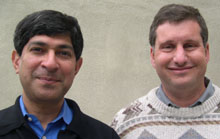 |
Scientist Dies Suddenly
During Visit to the Lab
Yesterday morning at around 11 a.m., George Virnovski, 59, a Russian-born scientist now living in Norway who was here for a daylong visit with Dmitriy Silin of the Earth Sciences Division, suffered from an apparent heart attack and immediately died. He was with Silin in Building 90 at the time. Medical, police and fire emergency personnel were summoned but could not revive him. Virnovski, who was collaborating on research with Silin, and his wife, Tamara, had arrived in the United States on Tuesday night and were guests in the home of Silin. Witnesses of this incident who are interested in speaking to a counselor can call UC Berkeley's CARE Services at 643-7754 or contact their HR Center.
 |
 |
|
 |
|
 |
|
| Kuriyan, left, and Robin |
|
Paths of ALS Scientists Cross Over Cancer Drug
“It’s a small world” is certainly an overused cliché, but there are times when it is very apt. Here’s an example: the father of David Robin, an accelerator physicist with the Advanced Light Source, was diagnosed with Chronic Myeloid leukemia. After suffering negative side effects with interferon, he was successfully treated with an experimental new drug called GLEEVEC. Later, while Robin was listening to a talk at a Washington D.C. conference, it was mentioned that the GLEEVEC structure was partially discovered at Brookhaven’s light source by John Kuriyan. Robin recognized the name…he was a visiting scientist working just down the hall at the ALS. When Robin got back to Berkeley, he e-mailed Kuriyan to see if his dad — who is now doing quite well — could come by to meet him. “During our visit, John explained how his research helped reveal GLEEVEC’s ability to stop some cancerous cell division,” says Robin. “It was a very gratifying experience for us.” Another coincidence: Robin led the ALS Superbend Project, which uses superconducting magnets to produce hard x-ray beams. The Superbends are the light source for the beamlines that Kuriyan has used to further study GLEEVEC, and were one of the main reasons he relocated here as a career employee.
Video of Chu Lecture
To State EPA Group
Lab Director Steve Chu presented a lecture on “The World’s Energy Problem and What We Can Do About It” on Feb. 27 to the State Environmental Protection Agency’s Air Resources Board. The talk was part of their Chair’s Air Pollution Seminar Series. Go here to watch the video.
 |
 |
|
 |
|
 |
New Web Page Highlights
Lab's Efficient Computing
A new Computing Sciences webpage showcases the breadth of energy-efficient computing research at Berkeley Lab. Scientists and engineers in the Computational Research, NERSC, and Environmental Energy Technologies divisions are working together to solve a significant problem faced by computing centers worldwide: how to engineer, build, and operate power-efficient computers and data centers. In addition to research on low-power processors and computer architectures, they also are examining efficiencies in network equipment and consumer electronics. Go here to view the site.
Clarification: Defense
Dept. Award for Lab
An article that ran in Tuesday’s edition of Today at Berkeley Lab listed the incorrect amount awarded by the Department of Defense to fund research on the use of geophysical imaging tools to verify the placement and subsurface distribution of soil amendments. The actual amount is $869,000 (not $89K, as reported by Environmental Protection magazine). The majority of the award will go to Berkeley Lab’s Earth Sciences, for research led by Susan Hubbard and assisted by Jonathan Ajo-Franklin. Go here to read a Daily Cal article on the research.
Chevron Carbon Expert
To Give Campus Talk
John Cain, principal carbon management advisor for Chevron, will give a talk on the UC Berkeley campus Wednesday, March 19, at noon in room 355 of the Goldman School of Public Policy (2607 Hearst Ave.). Cain will discuss “Greenhouse Gas Management: An Energy Company Perspective." The deadline to register for this event, which includes lunch, is tomorrow.
 |  |
|

